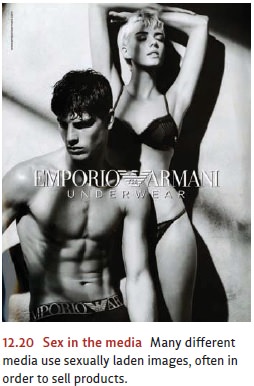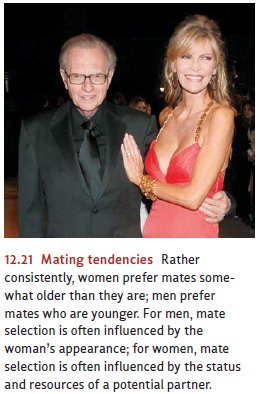Chapter: Psychology: Motivation and Emotion
Cultural and Cognitive Aspects of Sexuality
Cultural and Cognitive Aspects of Sexuality
As
we have seen, our sexual behavior clearly has powerful physiological bases. At
the same time, it also has substantial cultural and cognitive components. In
this section, we consider proximal situational determinants of sexual behavior
as well as more remote evolutionary determinants of mate choice.
SITUATIONAL DETERMINANTS OF SEXUAL BEHAVIOR
Sex
is everywhere—in billboard advertisements, on television, in movies, and in
supermarket tabloids (Figure 12.20). Do these sexually charged images encourage
sexual feelings and behaviors? Or do they give vent to our sexual desires and
thereby decrease our sexual behavior?

Laboratory
studies find that men typically report greater sexual arousal in response to
sexually explicit materials than women do (Gardos & Mosher, 1999). However,
this finding may in part reflect the fact that most sexually explicit materials
are developed to appeal to men rather than to women. When researchers presented
sexually explicit films that were chosen by women, there were no gender
differences in response to the films (Janssen, Carpenter, & Graham, 2003).
Does
this arousal actually encourage sexual behavior? Findings on this point have
been mixed, but it appears that exposure to such material does, for at least a
few hours, increase the likelihood of engaging in sexual behavior (Both,
Spiering, Everaerd, & Laan, 2004). Much more concerning, however, have been
findings from studies of the effects of sexually explicit material on sexual
attitudes. In one study, Zillmann and Bryant (1988) found that viewing sexually
explicit films made participants less satisfied with their partner’s appearance
and sexual performance. Far more troubling, films of women being sexually
coerced increased male participants’ willingness to harm women (Zillman, 1989).
In short, then, pornography may have a small effect in encouraging sexual
behavior, but it may have a larger effect on perceptions, and, worst of all, violent pornography has a more powerful
effect in encouraging sexual aggression.
MATE CHOICE
In
most cultures in the modern world, both men and women are selective in choosing
their sexual partners, and mating usually happens only when both partners
consent. However, the sexes differ in
the criteria they use in making their choices (Figure 12.21). According to a
number of surveys, the physical attractiveness of the partner seems more
important to men than to women, while the social and financial status of the
partner matters more to women than it does to men. It also appears that men
generally prefer younger women, whereas women prefer older men. The data also
indicate that all of these male-female differences are found in many countries,
including the United States, China, India, France, Nigeria, and Iran (D. M.
Buss, 1989, 1992; D. M. Buss & Barnes, 1986).

How
should we think about all of these points? In earily, we looked closely at the
evolutionary account: An attractive woman is likely to be healthy and fertile,
so a male selecting an attractive partner would increase his chances of
reproductive success. Likewise, a younger woman will have more reproductive
years ahead of her, so a male choosing a younger partner could plausibly look
forward to more offspring. Any male selecting his mates based on their youth and
beauty would be more likely than other males to have many healthy offspring to
pass along his genes. Thus, through the process of natural selection these
preferences eventually would become widespread among the males of our species.
The
female’s preferences are also sensible from an evolutionary perspective.
Because of her high investment in each child (at the least, 9 months of
carrying the baby in her womb, and then months of nursing), she can maximize
the chance of passing along her genes to future generations by having just a
few offspring and doing all she can to ensure the survival of each. A wealthy,
high-status mate would help her reach this goal, because he would be able to
provide the food and other resources their children need. Thus, there would be
a reproductive advantage associated with a preference for such a male, and so a
gradual evolution toward all females in the species having this preference
(Bjorklund & Shackelford, 1999; Buss, 1992; Schmitt, 2005).
We
also noted that cultural factors play an important role. For example, in many
cultures human females only come to prefer wealthy, high-status males because
the females have learned, across their lifetimes, the social and economic
advantages they will gain from such a mate. In these cultures, women soon learn
that their profes-sional and educational opportunities are limited, and so
“marrying wealth” is their best strategy for gathering resources for themselves
and their young.
The
importance of culture becomes clear when we consider cultures that provide more
opportunities for women. In these cultures, “marrying wealth” is not a woman’s
only chance for economic and social security, so a potential husband’s
resources become correspondingly less important in mate selection. Various studies
confirm this predic-tion and show that in cultures that afford women more
opportunities, women attach less priority to a male’s social and economic
status (Kasser & Sharma, 1999; also see Baumeister & Vohs, 2004;
Buller, 2005; Eagly & Wood, 1999; W. Wood & Eagly, 2002).
In
short, there seems to be considerable consistency in mating preferences and a
contrast between the criteria males and females typically use. This consistency
has been documented in many cultures and across several generations. But there
are also varia-tions in mate-selection preferences that are clearly
attributable to the cultural context. These data clearly illustrate the
interplay of biological and cultural factors that governs our motivational and
emotional states.
Related Topics